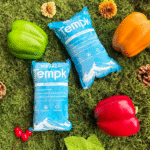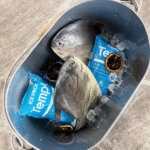Certainly! Here is a detailed, SEO-optimized article based on your specified guidelines and the keyword “laboratory dry ice packs”. The content is structured for optimal search engine ranking in 2025, adhering to On-Page SEO strategies.
Pacotes de gelo seco de laboratório: How to Choose the Best Option for Your Research?
Laboratories that handle sensitive materials like pharmaceuticals, espécimes biológicos, or chemicals require effective temperature control. É aqui que laboratory dry ice packs entrar em jogo. Neste artigo, we’ll explore what laboratory dry ice packs are, como eles funcionam, and how to choose the best one for your lab’s needs.

What Are Laboratory Dry Ice Packs?
Laboratory dry ice packs are specially designed cooling solutions used to keep substances at very low temperatures during transport and storage. Gelo seco, a forma sólida de dióxido de carbono, is extremely cold, maintaining a temperature of -78.5°C (-109.3°F). This makes it an ideal choice for cooling applications in laboratory settings, where precise temperature control is critical.
Dry ice packs are typically used in environments such as:
- Biological research
- Pharmaceutical shipping
- Medical supply transport
- Food preservation in scientific experiments
Why Use Laboratory Dry Ice Packs?
What Benefits Do Laboratory Dry Ice Packs Offer for Research?
Laboratory dry ice packs are essential for maintaining the integrity of temperature-sensitive samples. They provide several advantages:
- Stable Low Temperatures: Ao contrário do gelo regular, dry ice maintains an extremely low temperature for extended periods, which is crucial for preserving delicate samples during transport.
- Non-Melting: Gelo seco sublima diretamente de sólido ao gás, meaning it doesn’t leave liquid water behind, which could potentially damage sensitive materials.
- Vida útil estendida: Com isolamento adequado, dry ice packs can maintain temperatures below freezing for extended periods, helping to reduce spoilage and degradation of lab materials.
Usando Pacotes de gelo seco, laboratories can ensure the safe transportation of samples that require a constant low temperature, reducing the risk of spoilage and ensuring that the research process remains undisturbed.
How to Choose the Right Laboratory Dry Ice Packs?
What Factors Should You Consider When Selecting Dry Ice Packs?
When selecting the best laboratory dry ice packs, several factors should be taken into account to ensure the pack meets your specific needs. Estes incluem:
- Temperature Retention Duration: Depending on your needs, you might require dry ice packs that last for several hours or even days. Make sure to choose packs that match the length of your transport or storage requirements.
- Pack Size and Weight: Laboratory dry ice packs come in various sizes. Smaller packs are ideal for short-term use, while larger packs are necessary for extended storage or transportation.
- Isolamento: The insulation of the pack is crucial for maximizing the dry ice’s effectiveness. Packs with high-quality insulation will maintain a colder temperature for a longer time, reducing the frequency of replenishing the dry ice.
- Considerações Ambientais: Some labs may require eco-friendly options, such as dry ice packs made from recyclable or sustainable materials.
How to Calculate the Right Quantity of Dry Ice for Your Laboratory?
To determine the right quantity of dry ice needed, it’s important to calculate the thermal load of the materials you’re cooling. This involves considering:
- The volume of materials being transported
- The duration of cooling required
- The ambient temperature during transport
A general rule of thumb is that for every 5-10 kg of material, 1-2 kg of dry ice is needed for 24 horas de resfriamento. No entanto, it’s always best to consult the product’s specifications or ask an expert to ensure accuracy.
What are the Different Types of Laboratory Dry Ice Packs?
Laboratory dry ice packs come in several types, cada um adequado para finalidades diferentes. Estes incluem:
- Pre-packaged Dry Ice Packs: These are ready-to-use packs, typically found in smaller quantities, ideal for short-term use in smaller labs.
- Recipientes de gelo seco personalizados: Larger-scale laboratories often use custom containers that allow them to regulate the quantity of dry ice used. These can be tailored to specific temperature and insulation needs.
- Pacotes de gelo seco reutilizáveis: These packs can be refilled and reused, making them a cost-effective and environmentally-friendly option for long-term use.
Best Practices for Using Laboratory Dry Ice Packs
How Can You Maximize the Effectiveness of Your Dry Ice Packs?
- Use Proper Insulation: Ensure that your dry ice packs are stored in well-insulated containers. This reduces the sublimation rate and keeps the temperature consistently low.
- Avoid Opening the Pack Frequently: Opening the pack allows dry ice to sublimate faster. Only open it when necessary, and always work in well-ventilated areas.
- Monitorar temperatura: Use temperature data loggers to monitor the conditions inside the dry ice pack. This ensures that your materials are staying within the optimal temperature range.
What Safety Precautions Should You Take When Using Dry Ice?
Dry ice can be hazardous if not handled correctly. Always remember to:
- Use gloves when handling dry ice to avoid frostbite.
- Store dry ice in well-ventilated areas to avoid carbon dioxide buildup.
- Keep dry ice out of direct contact with the skin for prolonged periods.
Exemplo do mundo real: A pharmaceutical company used laboratory dry ice packs to transport temperature-sensitive drugs for a clinical trial. By using high-quality packs with extended retention times, they successfully kept the samples at the required temperatures, ensuring compliance with regulatory standards.
Laboratory Dry Ice Packs and Their Role in Research Advancements
How Do Laboratory Dry Ice Packs Support Scientific Innovation?
Laboratory dry ice packs play a critical role in ensuring the success of groundbreaking research. In fields such as biotecnologia e produtos farmacêuticos, where precision is key, dry ice helps maintain the integrity of valuable specimens and chemicals during testing and trials. Usando gelo seco, researchers can ensure that their samples stay at the desired temperature, which is essential for obtaining accurate and reliable results.
Emerging Trends in Dry Ice Use for Laboratories
À medida que a tecnologia evolui, so do the methods used to store and transport scientific materials. The latest trends in dry ice usage include:
- Smart Dry Ice Monitoring: New advancements in tracking technology allow researchers to monitor the condition of their dry ice packs in real-time, ensuring optimal temperature control.
- Gelo seco sustentável: Labs are increasingly focusing on sustainable practices. This includes using dry ice packs made from eco-friendly materials or opting for solutions that minimize waste.
Example Trend: One laboratory adopted a smart dry ice solution that included real-time temperature monitoring. This allowed them to reduce costs and minimize material wastage by ensuring the dry ice was used only when necessary.
Frequently Asked Questions About Laboratory Dry Ice Packs
Q1: How long can laboratory dry ice packs keep materials cold?
The duration depends on the size of the dry ice pack and the insulation used. Geralmente, laboratory dry ice packs can maintain a cold environment for anywhere from 24 para 72 horas, with proper insulation.
Q2: Posso reutilizar pacotes de gelo seco?
Sim, many dry ice packs are designed to be reusable, offering a more environmentally friendly and cost-effective solution for long-term use.
Q3: Are there eco-friendly options for laboratory dry ice?
Sim, several companies are now producing eco-friendly dry ice packs that use sustainable materials, reducing the environmental impact while maintaining efficiency.
Resumo e dicas práticas
Laboratory dry ice packs are an essential tool for any lab that handles temperature-sensitive materials. By choosing the right dry ice pack and implementing best practices, you can ensure the safe and effective transport of your samples, while contributing to more efficient and reliable research processes.
If you’re looking to ensure the safety of your samples, consider investing in high-quality laboratory dry ice packs that meet your specific cooling needs. Remember to assess your lab’s requirements, choose the right pack size and type, and always follow safety guidelines.
Meta Title and Description
Meta Title: Pacotes de gelo seco de laboratório: Best Solutions for Safe Sample Transport
Meta Descrição: Learn how to choose the best laboratory dry ice packs for maintaining temperature-sensitive materials. Explore types, usage tips, and safety practices for effective research transport.























